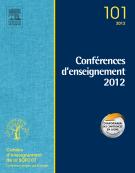Reprise des prothèses totales d’épaule : Revision of total shoulder arthroplasties - 14/11/13
| pagine | 11 |
| Iconografia | 12 |
| Video | 0 |
| Altro | 0 |
Résumé |
En France, la progression des reprises de prothèses d’épaule entre 2006 et 2010 est de 29 %. La littérature rapporte en moyenne 11 % de reprises dans les prothèses anatomiques, hémi- ou totales, et 10 % dans les prothèses inversées. La prise en charge d’une reprise de prothèse d’épaule nécessite un bilan initial rigoureux, clinique, biologique et d’imagerie pour répondre à cinq questions. Est-elle infectée? Est-elle instable? Est-elle usée? Est-elle descellée? Comment est la coiffe des rotateurs? Ce n’est qu’après ce bilan et une appréciation du stock osseux que l’indication de reprise pourra être posée. S’il s’agit d’une infection, la meilleure solution n’est pas toujours la dépose complète de la prothèse, lourde de conséquences fonctionnelles. La concertation pluridisciplinaire est essentielle pour la prise de décision. S’il s’agit d’une instabilité, la cause doit en être recherchée et traitée. Il s’agit souvent d’une insuffisance de restitution de la longueur humérale. S’il s’agit d’un descellement glénoïdien, le type de reconstruction doit être planifié en fonction de l’âge, de l’état de la coiffe et du capital osseux. Les possibilités de repose d’une glène anatomique sont rares, limitées aux cas avec une perte osseuse minime et une coiffe intacte. Si une greffe osseuse isolée est préférée, elle doit être tricorticale pour s’opposer à une usure et à une médialisation trop rapides. Dans les autres cas, une prothèse inversée avec autogreffe est préférable. Que la tige humérale soit descellée ou non, son ablation est souvent nécessaire. Il s’agit d’un temps difficile, risqué, source de complications, dominées par les fractures de l’humérus. La reconstruction dépend de la continence et de la hauteur du fourreau osseux restant. Dans toutes ces situations à risque, la concertation et l’information du patient sont essentielles.
Abstract – Revision of total shoulder arthroplasties
In France, the number of revision of total shoulder arthroplasties (TSA) has increased by 29% between 2006 and 2010. Literature reports approximately 11% of revisions for hemi- and total anatomical prostheses, and 10% for reverse prostheses. The decision to revise or not a TSA requires a rigorous, clinical, biological and imaging initial assessment to be done in order to answer five questions. It is infected? It is unstable? It is worn? Is there a loosening? How is the rotator cuff? This assessment and an evaluation of the bone stock are necessary to decide whether to revise or not. If the problem is infection, the best solution is not always complete removal of the prosthesis, which results in very poor shoulder function. In such a situation, a multidisciplinary concertation is essential for the decision-making. If the problem is instability, it is necessary to find its cause and to treat it. It is often due to insufficient restoration of the humerus length. If the problem is loosening, the type of revision must take into account the age, the status of the cuff and the bone stock. The possibilities to re-implant an anatomical glenoid are scarce, and only for the cases with minor bone loss and an intact cuff. If a bone graft without reimplantation of a glenoid component is preferred, it should be a tricortical graft, to resist wear and medialisation. In the other cases, a reverse prosthesis with an autograft is preferable. Whether or not the humeral stem is loose, it must often be removed. However, its removal is highly difficult, risky and it very often causes complications, among which the most common is fracture of the humerus. The possibility for reconstruction depends on the quality of the remaining bone stock. In all these risky situations, the patient should be duly informed and should take part in the decision-making process.
Vous pouvez accéder à la vidéo de cette conférence en cliquant Index.html?videoid=20
Mappa
© 2012 Elsevier Masson SAS. Tutti i diritti riservati.
Benvenuto su EM|consulte, il riferimento dei professionisti della salute.
L'accesso al testo integrale di questo articolo richiede un abbonamento o un acquisto all'unità.
Benvenuto su EM|consulte, il riferimento dei professionisti della salute.
L'accesso al testo integrale di questo articolo richiede un abbonamento.
Già abbonato a questo prodotto ?


